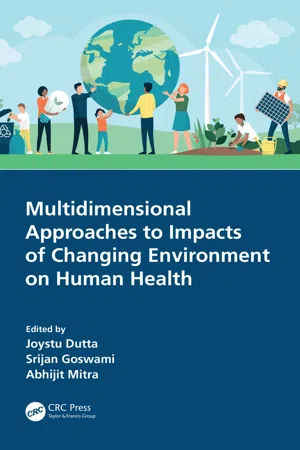Contents
3.1 Introduction
3.2Prevalence of S. aureus and MRSA in the Indoor Air of Indian Hospitals
3.3Prevalence of Airborne S. aureus in Non-Hospital Environments of India
3.4Transmission of S. aureus Through Air
3.5Environmental Factors Affecting S. aureus Survivability in the Air
3.6Health Impacts of Airborne S. aureus Exposure
3.7Bioaerosol Collection Methods for Airborne S. aureus
3.8Selective Growth Medium Used for Isolation of S. aureus and MRSA
3.9Culture-Independent Identification of Airborne S. aureus
3.10Current Air Decontamination Against S. aureus
3.11Guidelines to Reduce Airborne S. aureus and MRSA
3.12Conclusion
References
3.1 Introduction
Staphylococcus aureus (S. aureus) is an opportunistic pathogen, which persistently colonizes the nares of 20% of the human population, while the rest of the population carries it intermittently throughout their lifetime (Van Kampen, Hoffmeyer et al. 2016). Persistent carriers of S. aureus are the potential source of spreading infections, particularly in hospitals. Therefore it is frequently isolated from the hospital environment, including air (Naruka, Gaur et al. 2014) and frequently touched surfaces (Price, Cole et al. 2017; Dancer, Adams et al. 2019). S. aureus infections are associated with high mortality and morbidity, particularly in patients with weaker immunity such as children, those in old age, having open wounds, or suffering from immunity disorders and cancer. Approximately 50% of S. aureus isolates from hospitals (Kang, Jung et al. 2016; Latha, Anil et al. 2019) as well as non-hospital environments are identified as methicillin-resistant S. aureus (MRSA) (David and Daum 2010; Lin, Lin et al. 2016; Lee, de Lencastre et al. 2018).
S. aureus strains developed resistance to penicillin G soon after its introduction in the 1940s by acquiring ß-lactamase plasmids harboring blaZ gene, which could neutralize the ß-lactam ring of penicillin (Hiramatsu, Katayama et al. 2014a). In 1959, methicillin was introduced to kill ß-lactamase/penicillinase-containing S. aureus strains. Soon after introduction, in 1961, the first clinical isolate of MRSA was reported from a hospital in UK, and by the 1990s it had disseminated in community settings (Jevons 1961). MRSA was derived from methicillin-sensitive S. aureus (MSSA) after acquiring mecA gene by horizontal gene transfer mediated by a mobile genetic element, staphylococcal cassette chromosome (SCC) (Ito, Katayama et al. 1999). The SCC element carries a mecA gene encoding for an altered cell wall-synthesizing enzyme called penicillin-binding protein 2a (PBP2a), and a ccr gene complex for the mobility of the entire SCCmec element. The SCCmec element is highly diverse and has been classified into several types based on the different combination of mec and ccr gene complexes and J region (Hiramatsu, Ito et al. 2013). So far, four homologues of mec gene have been identified among methicillin-resistant staphylococci (MRS); these are mecA, mecB, mecC, and mecD (Lakhundi and Zhang 2018). To date, the SCCmec elements have been classified into 13 different types (Lakhundi and Zhang 2018). SCCmec typing is highly prevalent all over the world for MRSA molecular typing and epidemiological and evolution studies (Zhang, McClure et al. 2012).
Most alarmingly, MRSA strains have rapidly acquired resistance to multiple agents from different groups, including vancomycin and other new antimicrobial agents against MRSA (Hiramatsu, Cui et al. 2001; Hiramatsu, Katayama et al. 2014b; Watkins, Holubar et al. 2019). Such multidrug-resistant S. aureus (MDR-SA) are invincible as regards existing antibiotics and the new antimicrobial approaches are the need of the hour (Hiramatsu, Katayama et al. 2014a; Shariati, Dadashi et al. 2020). Although MRSA treatment is decided by clinical indication, currently MRSA strains are treated with vancomycin, clindamycin, daptomycin, linezolid, tedizolid, dalvabancin, tigecycline, etc. (Turner, Sharma-Kuinkel et al. 2019). Among many novel antimicrobials that are in the pipeline to tackle rising antimicrobial resistance (AMR) in MRSA, the development of host-defense peptides as anti-MRSA agents is very promising (Hancock and Sahl 2006). Our lab has been engaged in the development of alpha-melanocyte-stimulating hormone (alpha-MSH) against MRSA for over a decade and we have successfully confirmed the anti-MRSA activity of alpha-MSH mainly through membrane pore formation (Madhuri, Tahsina et al. 2009; Singh and Mukhopadhyay 2011, 2014; Singh, Mumtaz et al. 2020).
Apart from the increasing AMR in MRSA the other physiological and epidemiological properties remain the same between MSSA and MRSA, therefore, all the research regarding the S. aureus transmission cycle between infection and health workers and the environment is also relevant to MRSA (Dancer 2008).
S. aureus and MRSA are majorly responsible for nosocomial infections such as hospital-acquired pneumonia (HAP), bacteremia, surgical site infections, and skin an...
